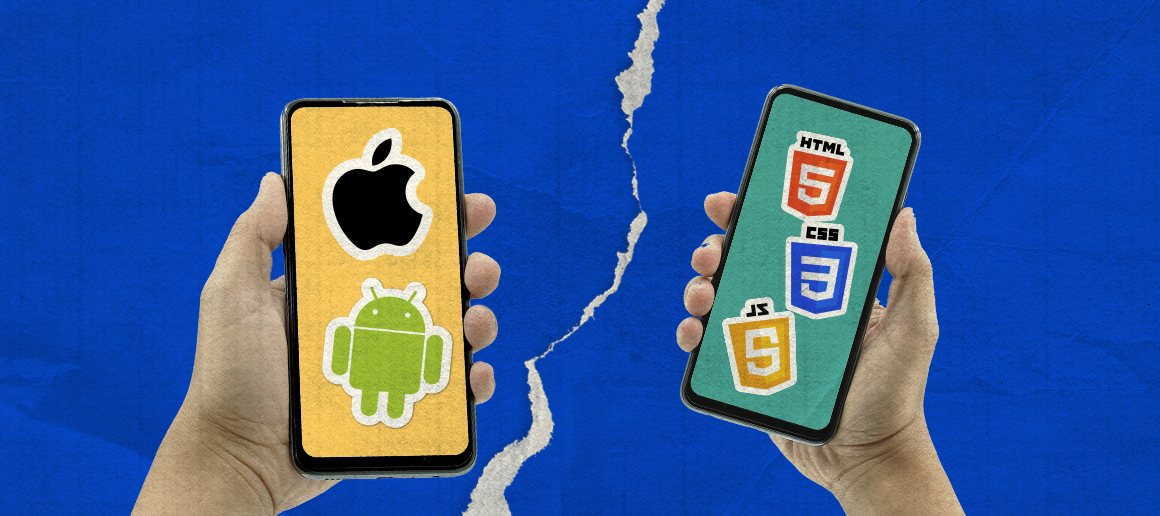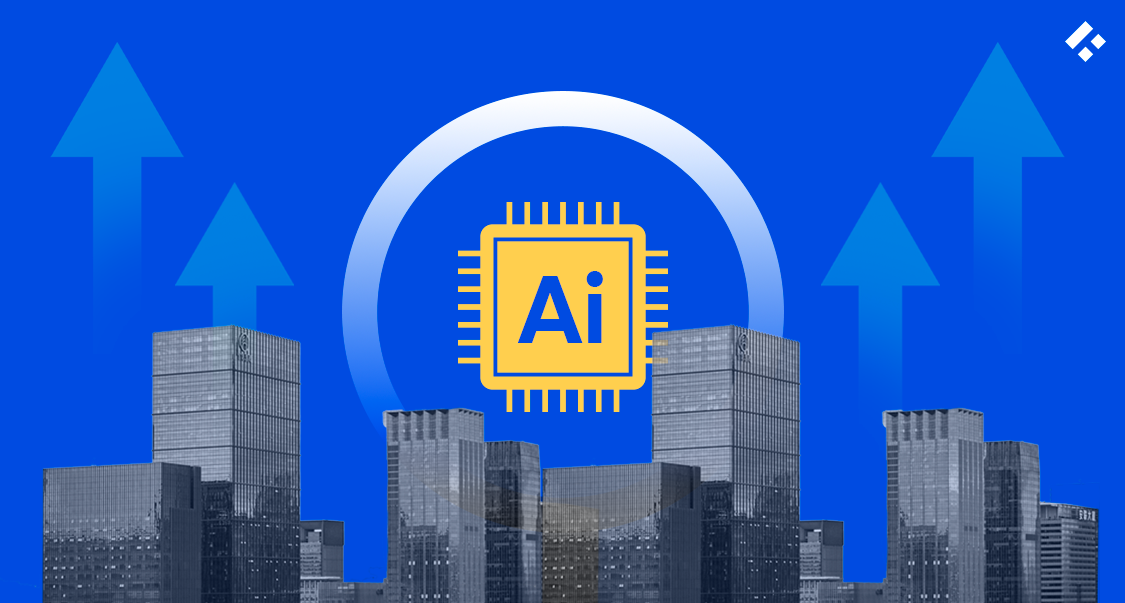Native vs. hybrid app development is a contentious topic of conversation in the software development community. As mobile ownership exponentially grows year after year, so does the importance of this conversation.
In 2011, only 35% of American mobile phone owners had smartphones. Today — as of April 2021 — 85% of Americans have a smartphone.
Considering that the average human is clicking, tapping, or swiping on their phone at least 2600 times a day, mobile app development sounds like a lucrative avenue for tech companies to go toward.
Native apps are often the go-to choice for the common mobile app developer who wants to get things done without sacrificing performance in the process. But hybrid app development can get things done too, and sacrificing performance isn’t always a prerequisite.
Though at one point, mobile apps could only rely on native app development, now not only are mainstream apps using hybrid app development, but hybrid app technologies have gotten so good, some can’t even tell the difference between a native app and a hybrid app.
If all this is true, then how are software developers and tech companies able to decide which development approach is best? There’s no easy answer for that.
But keep reading, and you’ll learn about the most significant differences between native vs. hybrid app development.
Are you ready to start your development project?
We have the developers you need to take your development project in the right direction.
Companies are proven to grow their business faster with Trio.
What Is a Native App?
Native apps are apps that are built using native app development. In native app development, mobile applications are built with the technologies and/or programming languages specific to their platform.
Java and Kotlin, for example, are the official programming languages for Android development. Therefore, Android developers create native apps for the Google Play Store using these languages.
In the same fashion, iOS native app developers employ the official languages for iOS development — Objective-C and Swift.
Advantages of Native Applications
The main benefits of native applications stem from their close relationship with the devices they are built for. Being native to the hardware of a device brings many advantages.
→ Performance
By far, the biggest advantage of native app development is performance. Native apps understand the hardware and software of their native devices more than any non-native app could.
As a result, navigation, page transitions, processing speed, and more demonstrate the peak of a device’s performance capabilities.
→ Functionality
Native apps can leverage the full functionality of the native devices that work with. Compatibility will never be an issue and native apps maintain a sense of reliability that non-native apps cannot.
Even user interfaces (UI) on native apps are better somehow, largely because the aesthetic of native apps will match that of your mobile device.
Disadvantages of Native Applications
The disadvantages of native applications involve the sheer amount of resources a business and/or software development team needs to build them.
→ Cost
Hiring a highly qualified team of software developers is difficult as it is. But when you go native, you’ll have to make distinct apps depending on the platform you want to launch your app on.
If you need both an iOS app and an Android app, for instance, you’ll need both Android and iOS developers. And that’ll cost twice as much.
→ Productivity
Since it’s likely that native mobile app developers will be working with multiple codebases, they won’t be as productive as developer teams that simply don’t have that need.
Native app development where multiple codebases are in order can lead to bottlenecks in management and production.
Putting your app out on the market will also take longer, the consequence being negative effects on your marketing scheme and frustration from your potential consumers who feel that they’ve been waiting too long for your new app.
What Is a Hybrid App?
Hybrid apps, unsurprisingly, are built using the methods of hybrid app development. In hybrid app development, mobile app developers utilize a mix of native technologies and web technologies.
Tagging along with these front-end web technologies is the concept of WebViews. Through WebViews, hybrid apps can display web content.
WebViews are a standard system component of smartphones. A WebView’s composition includes JavaScript, CSS, and HTML.
Hybrid app development may also take advantage of native elements to ensure that hybrid apps can interact with a phone’s features without compatibility issues.
Advantages of Hybrid Applications
Despite the amount of praise native apps get, hybrid app development is quickly increasing in popularity. The development process itself and marketing opportunities are some of the principal advantages of hybrid applications.
→ Reach
Hybrid apps have one job: to work on various platforms. Luckily, they do this job quite well. By building just one application with cross-platform access, you can guarantee consistency across the board via a single codebase.
One of the larger advantages of this type of reach is that users on all platforms can install your app.
This will play into a cycle that feeds itself. The more people who use your app and like it the more they will talk about your app. As users have access to your app on all platforms, word of mouth can usher in tangible benefits.
→ Efficiency
Of course, perhaps the greatest advantage of hybrid app development is that it’s efficient. You can save time in development because a single codebase can pull its weight on the most critical mobile platforms.
An increase in efficiency also signifies a decrease in development costs. You can hire simply one software development team who has skills in hybrid app-specific technologies, like Ionic for one.
Disadvantages of Hybrid Applications
The disadvantages of hybrid applications are important to consider as this is often what turns businesses away from hybrid app development. Weight the pros and cons carefully.
→ Accessibility
Accessibility in this sense refers to what hybrid apps lack. Given that they are non-native, access to inbuilt features for hybrid apps requires additional plugins and application programming interfaces (API), making development on the whole more complicated.
→ Availability
Hybrid apps depend on web technology, meaning that if you’re offline, performance suffers. Any interruption in your network connection could lead you and your app astray.
Native vs. Hybrid Apps: How Are They Different?
The advantages and disadvantages of native app development versus hybrid app development should give you a clearer picture of what you’re dealing with. Still, here’s a chart to parse things out just a bit more.
Note that this table is relative, and information prioritizes how the two approaches to development compare and contrast. There is no objective measure on how each development approach fares on its own.
| Native App Development | Hybrid App Development | |
| Performance | ⭐⭐⭐⭐⭐ | varies (depending on technologies used); between ⭐⭐⭐ — ⭐⭐⭐⭐⭐ |
| Codebase | multiple | single |
| Building & Maintenance | complex | (relatively) simple |
| Cost | high | low |
| Development Time | long | short |
| Availability (w/o Internet Connection) | ✅ |
5 Things To Look For When Choosing Between Native and Hybrid Apps
When you’re building a mobile app, there are certain particulars you have to be hyper-aware of before you make important decisions, especially when it comes to native app development versus hybrid app development.
Keep the following in mind:
1. Time & Cost of Development
Establishing clear and direct goals is an important part of managing any sort of development. Going into any project headfirst without a game plan is a big no-no.
You should have a decent understanding of the resources you have before you commit to a project. Take account of your budget and time constraints.
And make sure you let your software development team know, too. Such communication is integral to manifesting an agile software development process.
Once you’ve decided how much resources you’re willing to or able to spare for your mobile app development project, then you can decide whether you want to develop a hybrid app or a native app.
To review, hybrid apps will typically run a lot cheaper than native apps, as you only need to develop a single codebase.
2. User Experience (UX)
User experience should always be one of your top priorities where software development is concerned. There are many techniques to make certain the end-user is at the center of every step of the development process.
As an illustration, design thinking is one such technique. It is an iterative process in which developers seek to understand the end-user by challenging assumptions and defining and redefining problems.
But the question isn’t really how. Even if you have the brains to envision a seamless, interactive, and truly delightful user experience, the realization of this comes with a hefty price tag.
Native apps usually do best in the UX department but, as mentioned, they can be expensive. For some, going hybrid for its cost-effectiveness is worth the sacrifice of peak performance.
Related reading: What is Front-End Web Development? Everything You Need to Know
3. App Performance
Performance and UX have a strong correlation, so don’t be surprised to hear that hybrid apps suffer in this category as well.
Building highly performant hybrid apps are definitely possible and you can thank the latest hybrid technologies for that. That said, most still maintain that native apps have better performance than otherwise.
Their performance does not hinge on internet availability, so that’s one less obstacle to worry about. And back-end services for native apps have direct communication with their native hardware.
The UI also reaps the benefits as native apps can maintain the overall design of your native device. Plus, the front-end and back-end can work together more smoothly when they both have access to native features.
4. Monetization Model
Native mobile apps have an upper hand when they want to monetize their apps. The success of your app monetization is closely tied to CPM or ‘cost per 1000 impressions’.
Native mobile apps have a tendency to produce higher CPMs than anything on the web, including hybrid apps. To be clear, hybrid apps can be installed from your local app store but they are actually web apps wrapped in a native container.
Somewhat due to the fact that ad blockers are becoming increasingly common on web browsers, web apps do not gain as much advertising revenue as an in-app native ad would.
Related reading: What Is a Mobile App Business Plan and Why Is It Important?

Elevate Your Team with Trio AI Talent
Empower Your Projects with Trio’s Elite Tech Teams
5. Developers’ Availability & Knowledge
Naturally, the success of your mobile app is secondary to the skill set of your developers.
Whether you’re going for hybrid or native app development, having developers who are acutely familiar with your project’s goals and the knowledge necessary to fulfill them is a must.
Trio can help you understand how to hire developers. What’s more, if you’re interested, we have skilled developers in both native, hybrid, and even cross-platform technologies. See below:
- Hire iOS developers
‣ Hire Swift developers - Hire Android developers
‣ Hire Java developers
‣ Hire Kotlin developers - Hire Flutter developers
- Hire Xamarin developers
- Hire React Native developers

Conclusion
The choice between native vs. hybrid app development is daunting. Hybrid app development can be a quick save for tech companies who want to get a jumpstart in mobile app development, but don’t have the means to commit to native development.
On the other hand, native app development never ceases to be a worthwhile choice. High performance and high revenue-producing ads only describe a few of the advantages that native app development can bring.
Either way, building a mobile app should not be a split-second decision.
To learn more about mobile app development, check out this Trio resource: How To Build a Mobile App!






